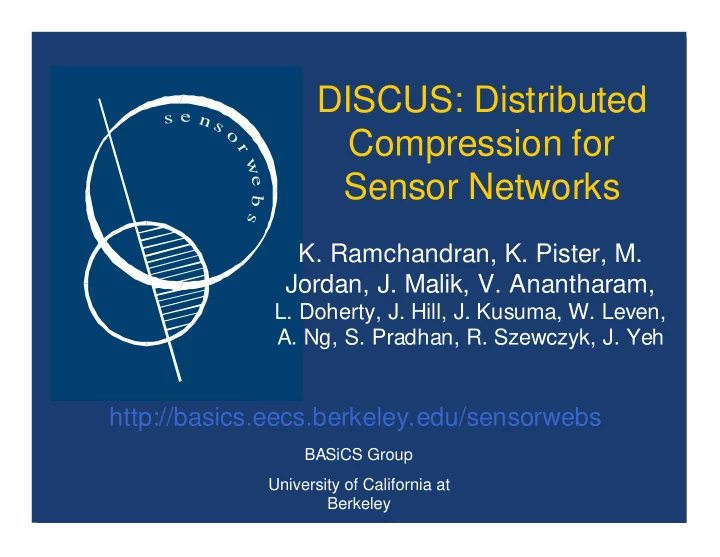

DISCUS: Distributed e s n s o Compression for r w Sensor Networks e b s K. Ramchandran, K. Pister, M. Jordan, J. Malik, V. Anantharam, L. Doherty, J. Hill, J. Kusuma, W. Leven, A. Ng, S. Pradhan, R. Szewczyk, J. Yeh http://basics.eecs.berkeley.edu/sensorwebs BASiCS Group University of California at Berkeley
Motivations � SmartDust and MEMS: quantum leap in device and computing device technology � Excellent platform for efficient, smart devices and collaborative, distributed theory and algorithms � Bring unified theoretical approach to address specific scenarios � Sensor networks -> correlated observations: want to compress in efficient and distributed manner University of California, Berkeley
Mission Statement Correlated information Experimental testbed to � leverage advances in SmartDust MEMS technology and demonstrate developed theories and algorithms -- the BCSN (Berkeley Campus Sensor Network). University of California, Berkeley
Scenario: correlated observations � Varying temperature field Information Theory: can gain performance boost thanks to correlation DISCUS: constructive way of harnessing correlation for blind joint compression close to optimum Central Decoder University of California, Berkeley
At The End of The Day � Want to compress [ H(y), H(x|y) ] correlated observations � Don’t want communication 7 6 between motes 5 R 4 y 3 [ H(x), H(y|x) ] 3 4 5 6 7 R Source 1 Encoder 1 x R x Joint correlated Decoder R Encoder 2 Source 2 y University of California, Berkeley
Distributed Compression � Slepian-Wolf, Wyner-Ziv (ca. 70’s): information-theoretically can jointly compress correlated observations, even with no communication between motes. [ H(y), H(x|y) ] Source 1 Encoder 1 Joint correlated 7 6 R Decoder 5 y 4 Encoder 2 3 Source 2 [ H(x), H(y|x) ] 3 4 5 6 7 R x � DISCUS: constructive framework, using well- studied error-correcting codes from coding theory. University of California, Berkeley
Source Coding with Side Information – discrete alphabets � X and Y => length-3 binary data (equally likely), � Correlation: Hamming distance between X and Y is at most 1. Example: When X=[0 1 0], Y => [0 1 0], [0 1 1], [0 0 0], [1 1 0]. R ≥ ( | ) H X Y System 1 X X = ˆ X Decoder Encoder � X and Y correlated � Y at encoder and decoder Y 0 0 0 Need 2 bits to index this. 0 0 1 X+Y= 0 1 0 1 0 0 University of California, Berkeley
R ≥ System 2 ( | ) H X Y X X = ˆ X Encoder Decoder � X and Y correlated � Y at decoder Y � What is the best that one can do? Y � The answer is still 2 bits! 000 001 X 010 100 0 0 0 How? Coset-1 1 1 1 111 110 101 011 University of California, Berkeley
0 0 1 0 0 0 � � � � Coset-2 Coset-1 � � � 1 1 0 1 1 1 � � 0 1 0 1 0 0 � � � � Coset-3 Coset-4 � � � � 1 0 1 0 1 1 � � � Encoder -> index of the coset containing X. � Decoder ->X in given coset. Note: � Coset-1 -> repetition code. � Each coset -> unique “syndrome” � DIstributed Source Coding Using Syndromes University of California, Berkeley
Discrete case – handwaving argument � Consider abstraction using lattices � Correlation structure translates to distance between X and Y � Suppose X and Y have distance at most 1 � How to compress X if we know that Y is close to X? � Use cosets! � Partition lattice space into cosets and send coset index! University of California, Berkeley
A little accounting � How much have we compressed? � Without compression: log 2 36 bits � With compression: log 2 9 bits X Y University of California, Berkeley
And now the math cleanup! � Can use well-studied channel codes to build codes on euclidean space! � Basic idea: want to select points as far apart as possible (i.e. cosets) – done using channel codes � Send ambiguous information, side information will disambiguate information! � Can use Hamming, TCM, RS, etc. codes University of California, Berkeley
Generalized coset codes: a/symmetric applications � How to compress to Hexagonal Lattice arbitrary (but information- theoretically sound) rates? � Use lattice idea again: 2 encoders send ambiguous information, Encoder-1 but only one true Encoder-2 answer that satisfy correlation constraint University of California, Berkeley
Continuous case – quantization and estimation � Modular boxes: Quant Discrete Discrete Estim izer Encoder Decoder ator University of California, Berkeley
Gaussian case example � Estimation with side information: – First quantize sensor information – Use discrete DISCUS encoders / decoders – Estimate given decoder output and side information [ ] ˆ = ∈ Γ | , X E X Y X i University of California, Berkeley
No Such Thing as Free Lunch � Big issue: finer quantization means larger error distances – need stronger code to enable finer quantization!!! University of California, Berkeley
Deployment Scenario � Observe readings: learn correlation � Use clustering algorithm � Assign codebooks to different motes � Can rotate “centroid” mote in each group � Centroid mote report to central decoder University of California, Berkeley
Dynamic Tracking Scenario � Wish to dynamically update clustering � Good news: no need for child nodes to be aware!!! Codebook assignment not an issue! � Only central decoder needs to be aware of clustering � Can also rotate centroid node within each cluster: can detect correlation changes University of California, Berkeley
Conclusions � Can use efficient error-correcting codes to enable distributed compression � Power/bandwidth/quality tradeoff through quantization and codebook selection � Very little work for encoders! � Tremendous gains in a sensor network University of California, Berkeley
Recommend
More recommend